Economic Impact and Risk Assessment of Sand and Dust Storms (SDS) on the Oil and Gas Industry in Kuwait
Abstract
1. Introduction
1.1. Sand and Dust Storms: Definition, Sources, and Trajectories
1.2. Economic Studies of SDSs
1.3. Economic Impact and Evaluation of SDSs
2. Methods
3. Results
3.1. SDS Frequency and Severity in Kuwait
3.2. SDS Impact on Oil and Gas Operations
3.2.1. Drilling Operations
3.2.2. Production Operations
3.2.3. Gas Operations
3.2.4. Exploration
3.2.5. Port and Marine Operations
3.2.6. Soil Remediation
3.2.7. Project Management
3.2.8. Water Handling
3.2.9. Maintenance, Support, and Reliability
3.2.10. Research and Development (R&D)
3.2.11. Sand Encroachment
3.3. Risk Assessment Matrix
3.4. Mitigation and Control of SDS
4. Discussion
5. Conclusions
Author Contributions
Funding
Acknowledgments
Conflicts of Interest
References
- McTainsh, G.; Pitblado, J. Dust storms and related phenomena measured from meteorological records in Australia. Earth Surf. Process. Landf. 1987, 12, 415–424. [Google Scholar] [CrossRef]
- Shepherd, G.; terradellas, E.; Baklanov, A.; Kang, U. Global Assessment of Sand and Dust Storms; UNEP: Nairobi, Kenya, 2016. [Google Scholar]
- Tozer, P.; Leys, J. Dust storms—What do they really cost? Rangel. J. 2013, 35, 131–142. [Google Scholar] [CrossRef]
- Thalib, L.; Al-Taiar, A. Dust storms and the risk of asthma admissions to hospitals in Kuwait. Sci. Total Environ. 2012, 433, 347–351. [Google Scholar] [CrossRef] [PubMed]
- Draxler, R.; Gillette, D.; Kirkpatrick, J.; Heller, J. Estimating PM10 air concentrations from dust storms in Iraq, Kuwait and Saudi Arabia. Atmos. Environ. 2001, 35, 4315–4330. [Google Scholar] [CrossRef]
- Middleton, N.; Yiallouros, P.; Kleanthous, S.; Kolokotroni, O.; Schwartz, J.; Dockery, D.; Demokritou, P.; Koutrakis, P. A 10-year time-series analysis of respiratory and cardiovascular morbidity in Nicosia, Cyprus: The effect of short-term changes in air pollution and dust storms. Environ. Health 2008, 7, 39. [Google Scholar] [CrossRef] [PubMed]
- Middleton, N.J. Desert dust hazards: A global review. Aeolian Res. 2017, 24, 53–63. [Google Scholar] [CrossRef]
- United Nations Convention to Combat Desertification (Secretariat). Global Alarm: Dust and Sandstorms from the World’s Drylands; United Nations Publications: Bangkok, Thailand, 2001. [Google Scholar]
- Martínez-Graña, A.M.; Goy, J.L.; Zazo, C. Water and Wind Erosion Risk in Natural Parks—A Case Study in “Las Batuecas–Sierra de Francia” and “Quilamas” Protected Parks (Central System, Spain). Int. J. Environ. Res. 2014, 8, 61–68. [Google Scholar] [CrossRef]
- Martínez-Graña, A.M.; Goy, J.L.; Zazo, C. Cartographic procedure for the analysis of aeolian erosion hazard in natural parks (Central System, Spain). Land Degrad. Dev. 2015, 26, 110–117. [Google Scholar] [CrossRef]
- Noy, I.; Yonson, R. Economic Vulnerability and Resilience to Natural Hazards: A Survey of Concepts and Measurements. Sustainability 2018, 10, 2850. [Google Scholar] [CrossRef]
- Wood, N. Understanding Risk and Resilience to Natural Hazards; US Geological Survey: Vancouver, WA, USA, 2011.
- Mamouri, R.-E.; Ansmann, A.; Nisantiz, A.; Solomos, S.; Kallos, G.; Hadjimitsis, G. Extreme dust storm over the eastern Mediterranean in September 2015: Satellite, lidar, and surface observations in the Cyprus region. Atmos. Chem. Phys. 2016, 16, 13711–13724. [Google Scholar] [CrossRef]
- Husar, R.; Tratt, D.; Ascichtel, S.; Falke, S.; Li, F.; Jaffe, D.; Gasso, S.; Gill, T.; Laulainen, N.; Lu, F.; et al. Asian dust events of April 1998. J. Geophys. Res. 2001, 106, 18317–18330. [Google Scholar] [CrossRef]
- Jugder, D.; Shinoda, M.; Sugimoto, N.; Matsui, I.; Nishikawa, M.; Park, S.-U.; Chun, Y.-S.; park, M.-S. Spatial and temporal variations of dust concentrations in the Gobi Desert of Mongolia. Glob. Planet. Chang. 2011, 78, 14–22. [Google Scholar] [CrossRef]
- Cao, H.; Amiraslani, F.; Liu, J.; Zhou, N. Identification of dust storm source areas in West Asia using multiple environmental datasets. Sci. Total Environ. 2015, 502, 224–235. [Google Scholar] [CrossRef] [PubMed]
- Al-Dousari, A.; Doronzo, D.; Ahmed, M. Types, indications and impact evaluation of sand and dust storms trajectories in the Arabian Gulf. Sustainability 2017, 9, 1526. [Google Scholar] [CrossRef]
- Yassin, M.; Almutairi, S.; Al-Hemoud, A. Dust storms backward Trajectories’ and source identification over Kuwait. Atmos. Res. 2018, 212, 158–171. [Google Scholar] [CrossRef]
- Al-Hemoud, A.; Al-Sudairawi, M.; Neelamanai, S.; Naseeb, A.; Behbehani, W. Socioeconomic effect of dust storms in Kuwait. Arab. J. Geosci. 2017, 10, 18. [Google Scholar] [CrossRef]
- Meibodi, A.; Abdoli, G.; Taklif, A.; Morshedi, B. Economic modeling of the regional policies to combat dust phenomenon by using game theory. Procedia Econ. Financ. 2015, 24, 409–418. [Google Scholar] [CrossRef]
- Miri, A.; Ahmadi, H.; Ekhtesasi, M.; Panjehkeh, N.; Ghanbari, A. Environmental and socio-economic impacts of dust storms in Sistan Region. Iran. Int. J. Environ. Stud. 2009, 66, 343–355. [Google Scholar] [CrossRef]
- Ekhtesasi, M.; Sepehr, A. Investigation of wind erosion process for estimation, prevention, and control of DSS in Yazd–Ardakan plain. Environ. Monit. Assess. 2009, 159, 267. [Google Scholar] [CrossRef]
- Ai, N.; Polenske, K. Socioeconomic impact analysis of yellow-dust storms: An approach and case study for Beijing. Econ. Syst. Res. 2008, 20, 187–203. [Google Scholar] [CrossRef]
- Jeong, D. Socio-economic costs from yellow dust damages in South Korea. Korean Soc. Sci. J. 2008, 35, 1–29. [Google Scholar]
- Williams, P.; Young, M. Costing Dust: How Much Does Wind Erosion Cost the People of South Australia; CSIRO Land Water: Glen Osmond, South Australia, 1999. [Google Scholar]
- Huszar, P.; Piper, S. Estimating the off-site costs of wind erosion in New Mexico. J. Soil Water Conserv. 1986, 41, 414–416. [Google Scholar]
- OPEC. OPEC Annual Statistical Bulletin; Organization of the Petroleum Exporting Countries: Vienna, Austria, 2017. [Google Scholar]
- Eller, R.; Zemore, M.; Kady, R. Standard Practice for System Safety (MIL-STD 882D and E); U.S. Department of Defense: Wright-Patterson AFB, OH, USA, 2000.
- Clemens, P.; Simmons, R. The Risk Exposure Interval-Too Often an Analyst’s Trap. J. Syst. Saf. 2001, 37, 8–16. [Google Scholar]
- Saeed, T.; Al-Dashti, H. Optical and physical characterization of “Iraqi freedom” dust storm, a case study. Theor. Appl. Climatol. 2011, 104, 123–137. [Google Scholar] [CrossRef]
- Brimblecombe, P. Air Composition and Chemistry; Cambridge University Press: Cambridge, UK, 1996; ISBN 0521453666. [Google Scholar]
- Al-Sudairawi, M.; Misak, R.; Kwarteng, A.; Abdulla, J.; Al-Dousari, M.; Gharib, I.; Zaghloul, M.; Ahmed, M.; Boctor, N.; Abdulla, O. Study of Sand Control at KOC Operation Areas of Southeast, West and North Kuwait; Final Report; Kuwait Institute for Scientific Research: Safat, Kuwait, 1999. [Google Scholar]
- Al-Dousari, A. Sedimentological, Geomorphological and Mineralogical Characteristics of Mobile Sand and Anchored Dunes in Northwestern Kuwait; Royal Holloway, University of London: Egham, UK, 2003. [Google Scholar]
- Sabbah, I.; Leon, J.-F.; Sorribas, M.; Guinot, B.; Cordoba-Jabonero, C.; de Souza, A.; Al Sharifi, F. Dust and dust storms over Kuwait: Ground-based and satellite observations. J. Atmos. Sol.-Terr. Phys. 2018, 179, 105–113. [Google Scholar] [CrossRef]
- Pimentel, D.; Harvey, C.; Resosudarmo, P.; Sinclair, K.; Kurz, D.; McNair, M.; Crist, S.; Shpritz, L.; Fitton, L.; Saffouri, R.; et al. Environmental and economic costs of soil erosion and conservation benefits. Science 1995, 267, 1117–1123. [Google Scholar] [CrossRef] [PubMed]
- Riksen, M.; De Graaff, J. On-site and off-site effects of wind erosion on European light soils. Land Degrad. Dev. 2001, 12, 1–11. [Google Scholar] [CrossRef]
- Al-Dousari, A.; Ahmed, M.; Al-Dousari, N.; Al-Awadhi, S. Environmental and economic importance of native plants and green belts in controlling mobile sand and dust hazards. Int. J. Environ. Sci. Technol. 2018, 1–12. [Google Scholar] [CrossRef]
- Ahmed, M.; Al-Dousari, A.; Al-Mutairi, M. A Study of the Cost and History of Sand Encroachment Problems in Kuwait; Final Report; Kuwait Institute for Scientific Research: Safat, Kuwait, 1999. [Google Scholar]
- Dabanli, I. Drought hazard, vulnerability, and risk assessment in Turkey. Arab. J. Geosci. 2018, 11, 538. [Google Scholar] [CrossRef]
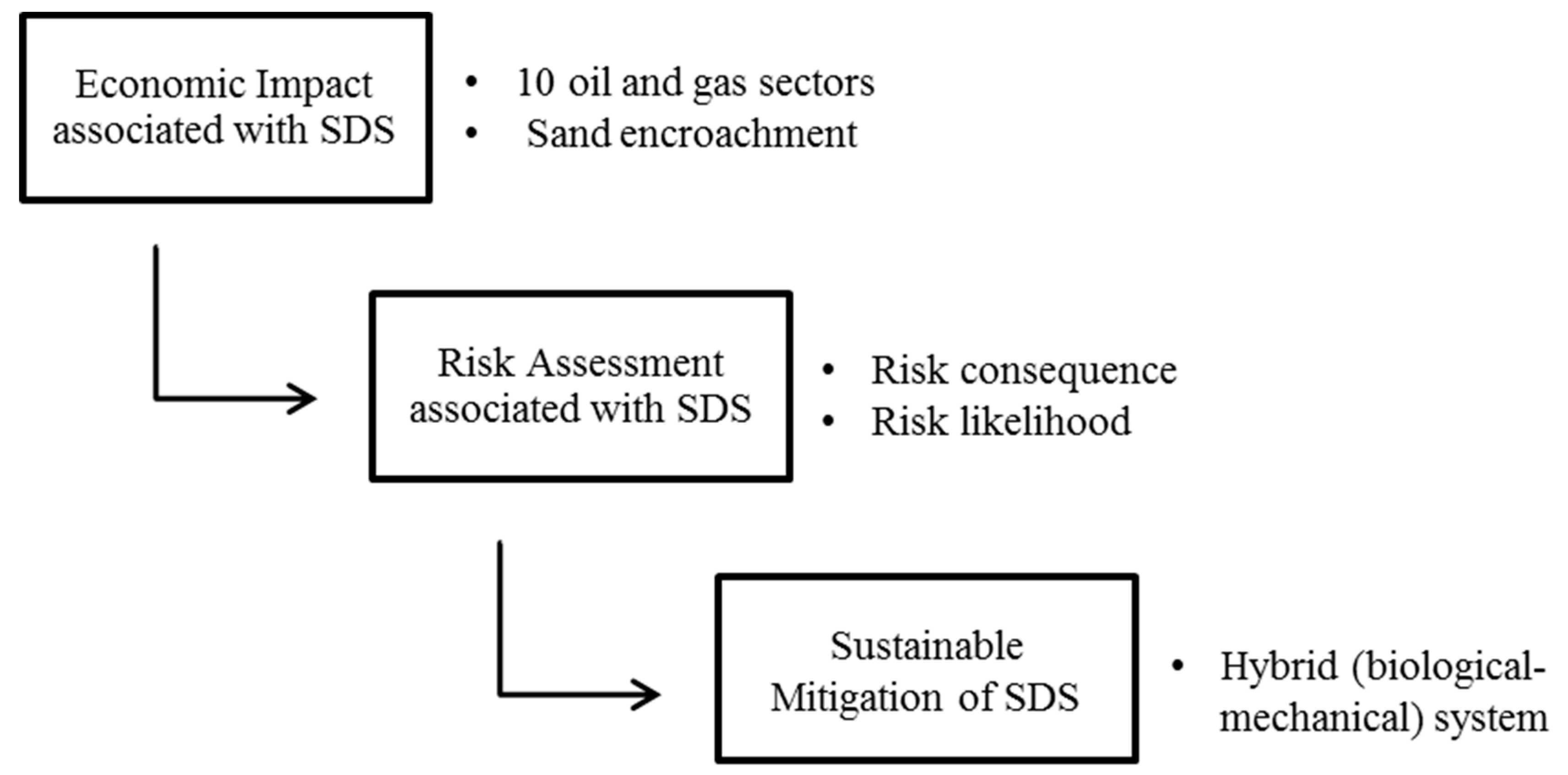
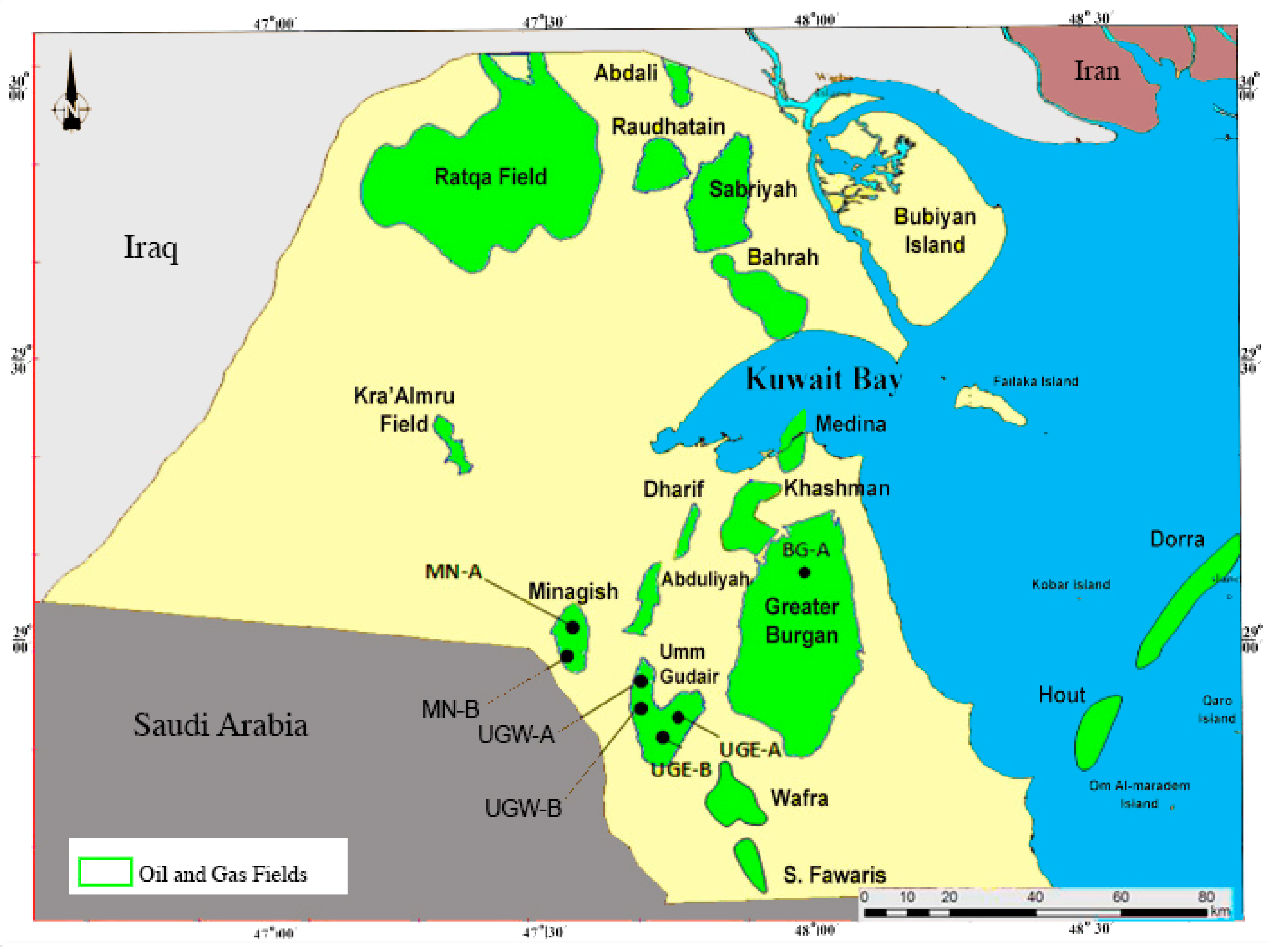
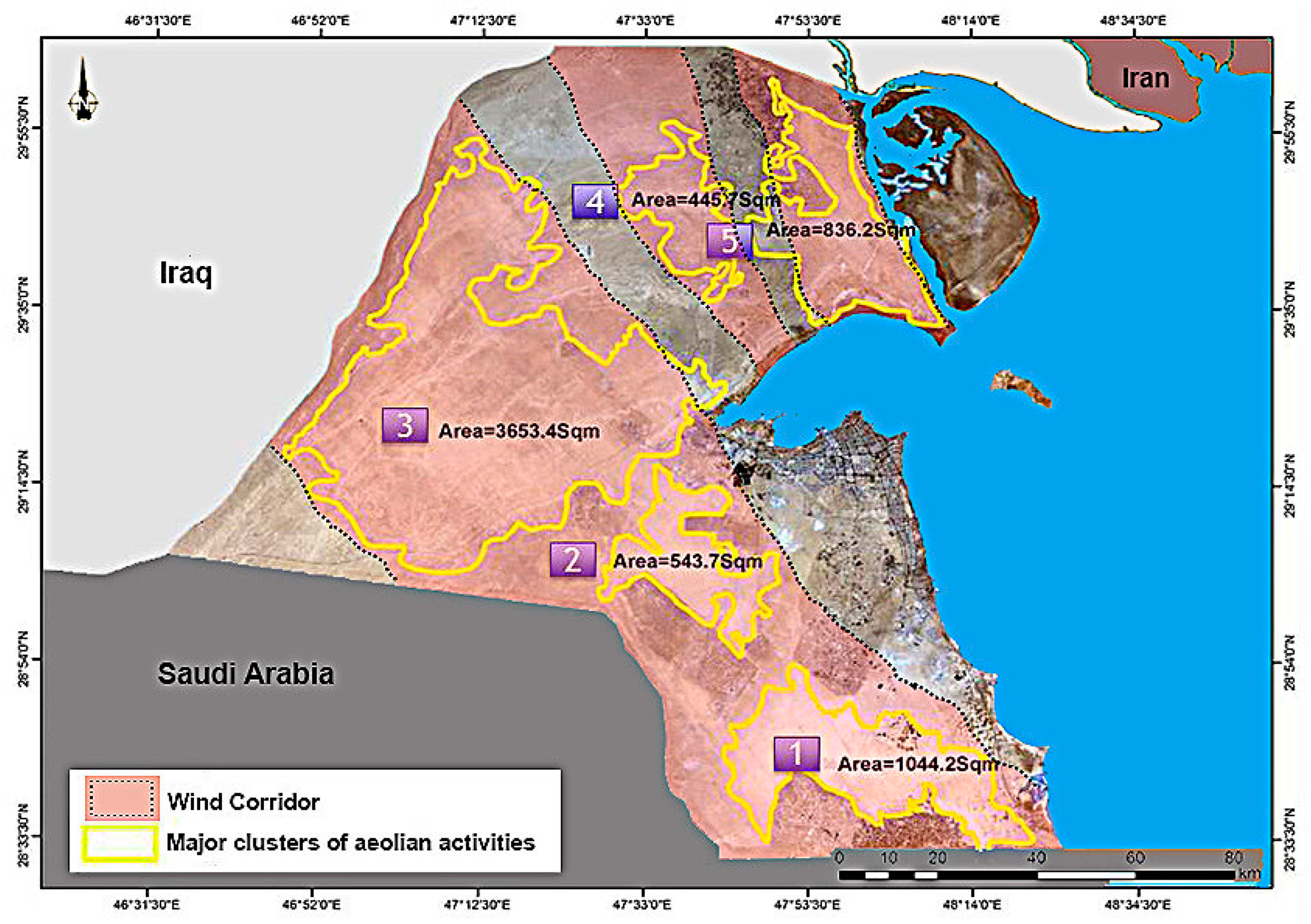

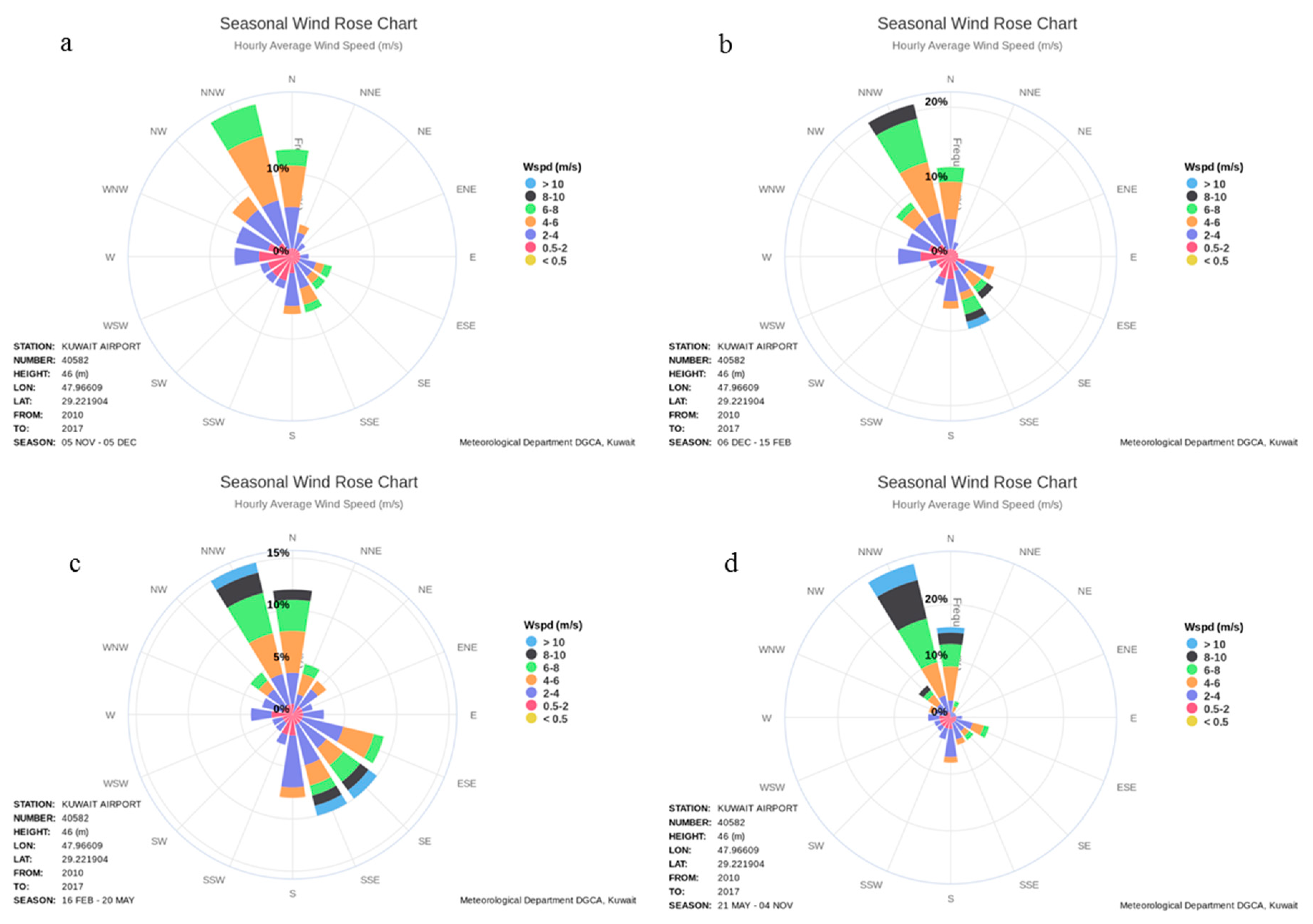
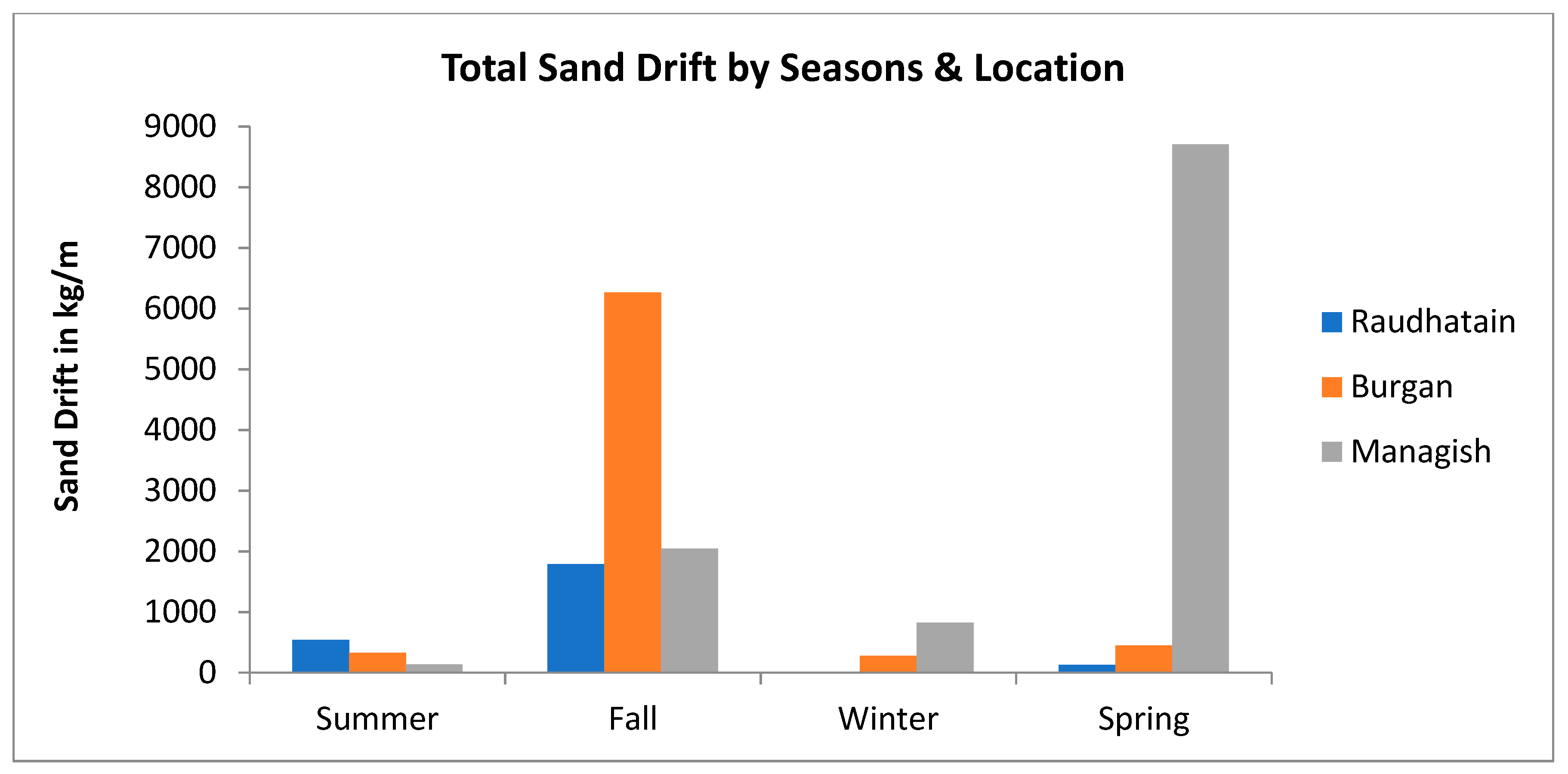
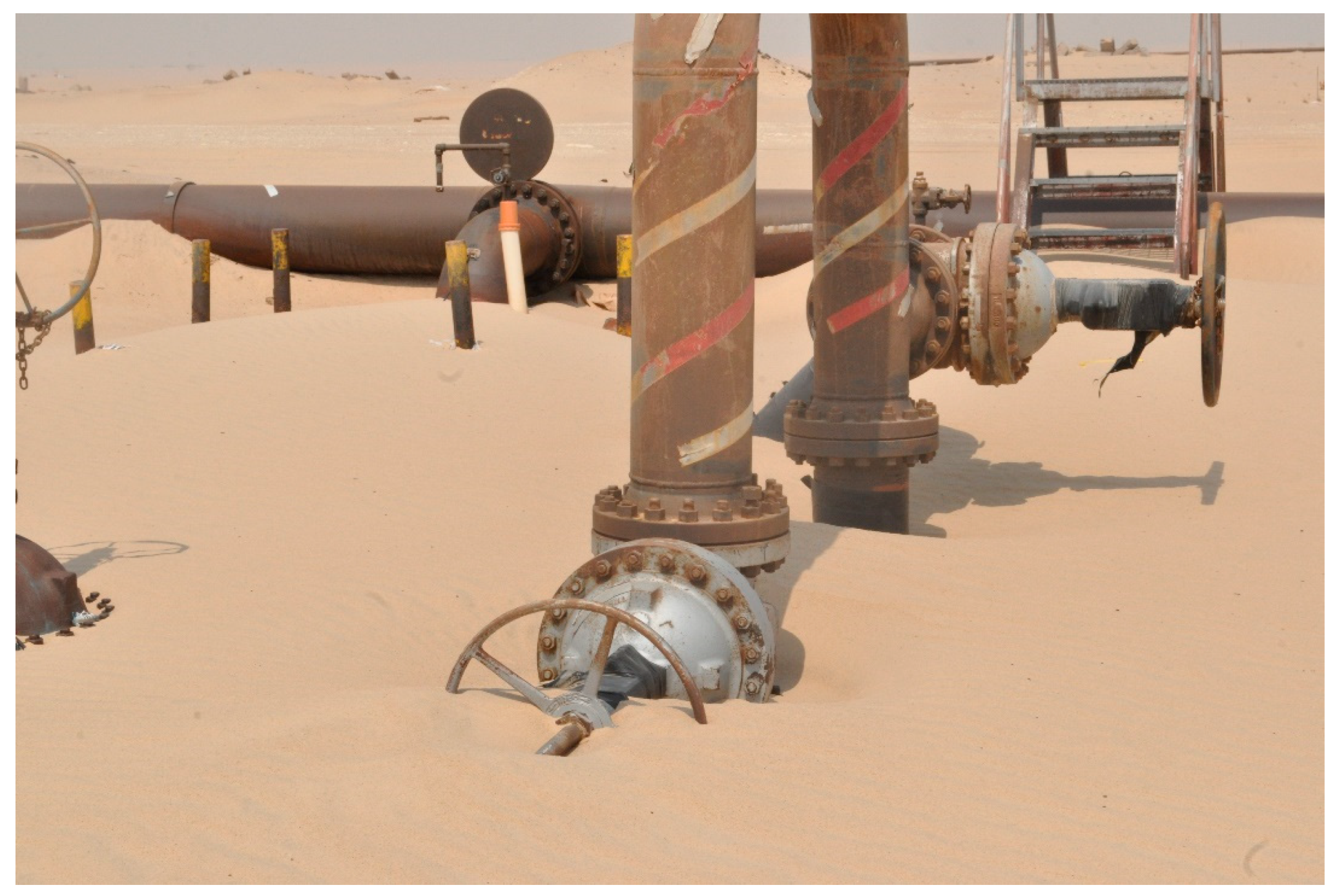
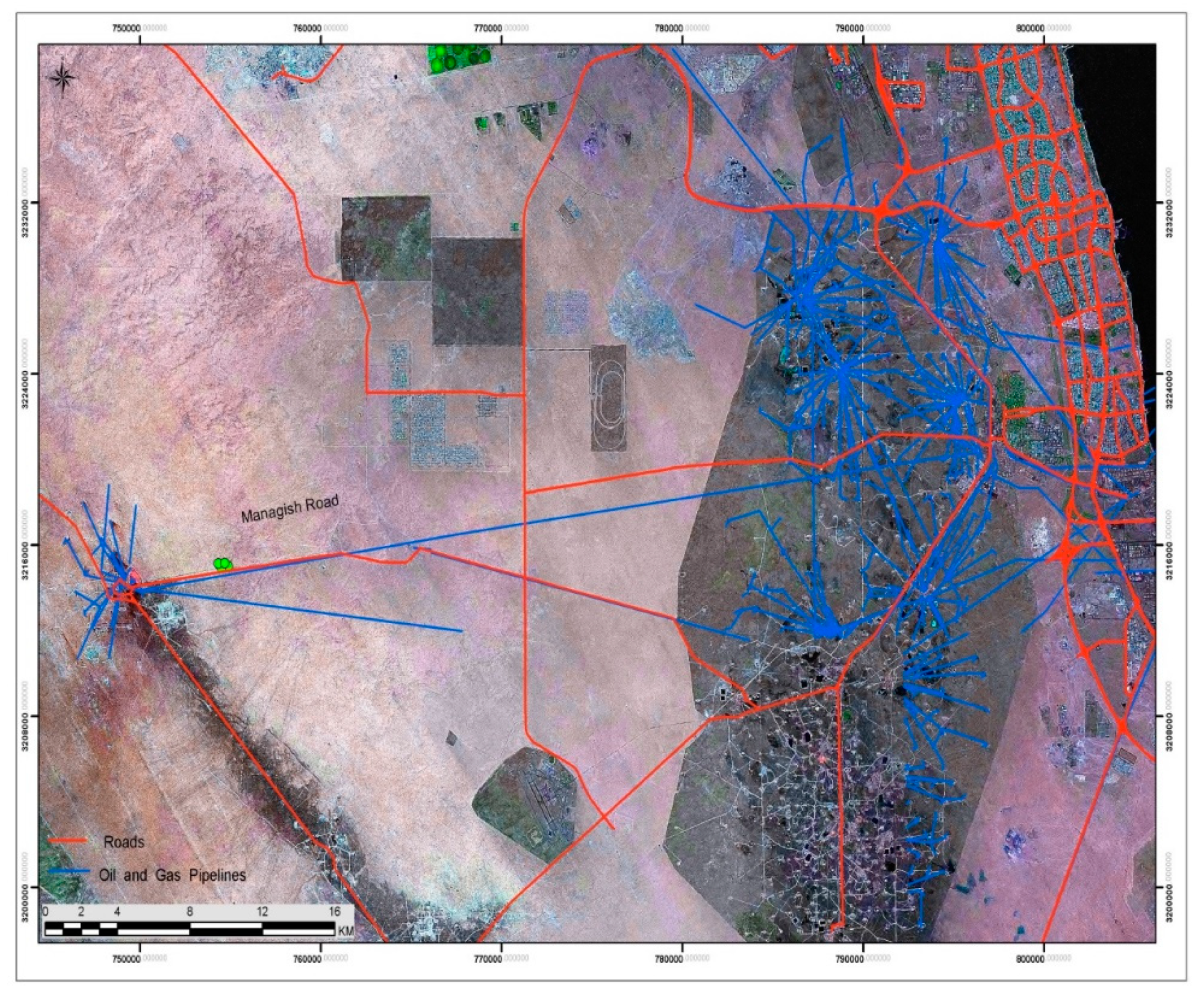
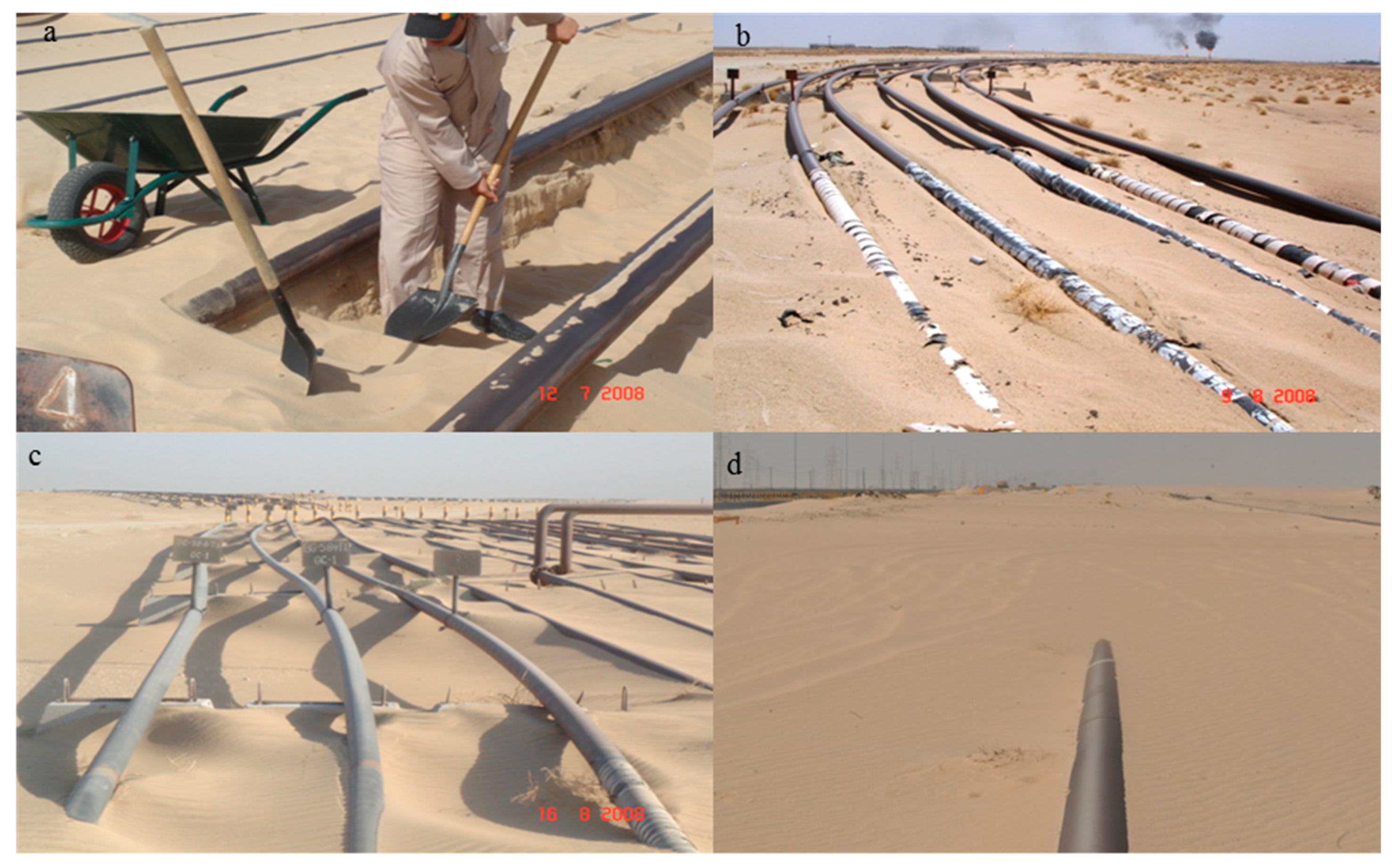
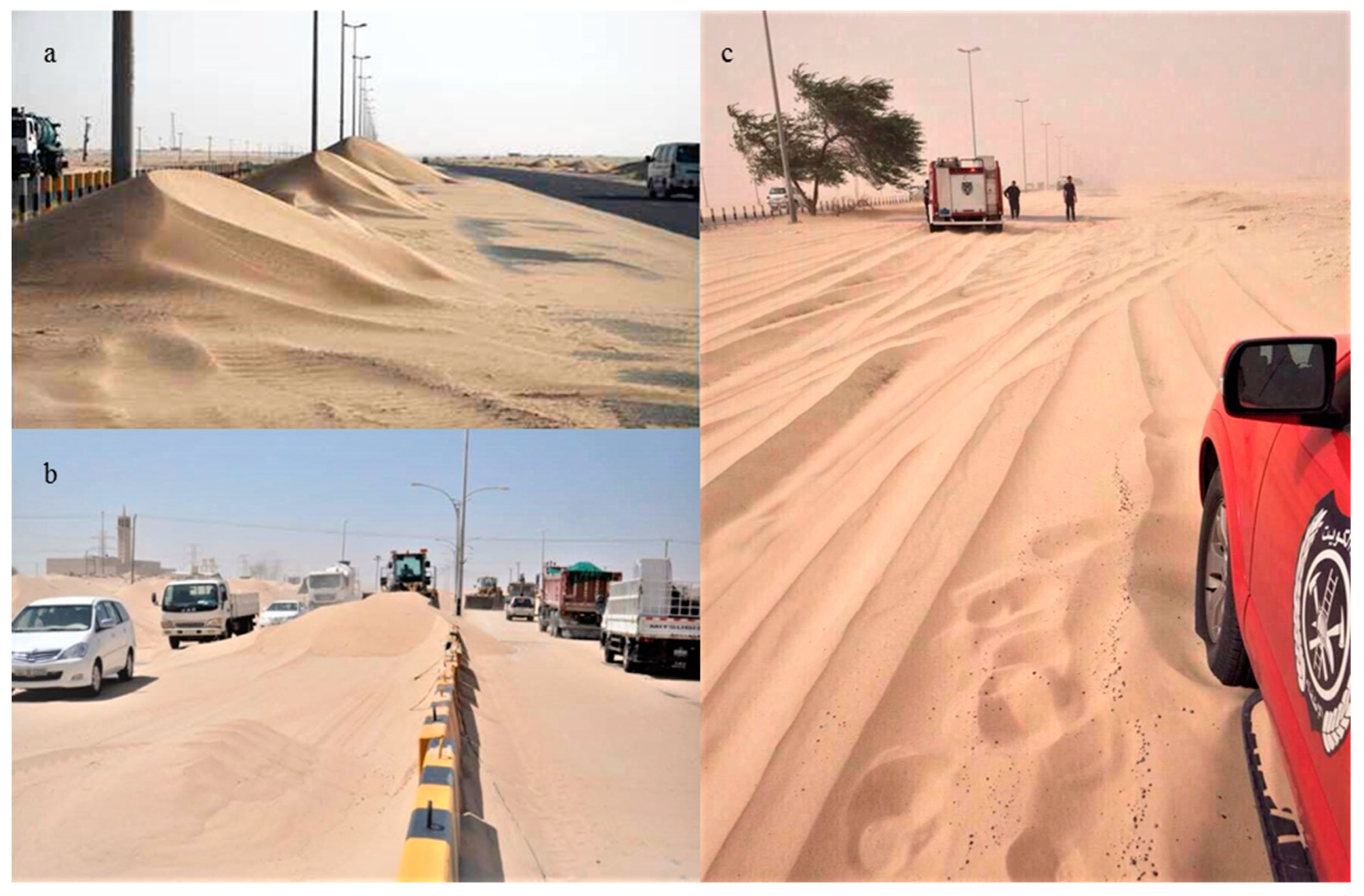
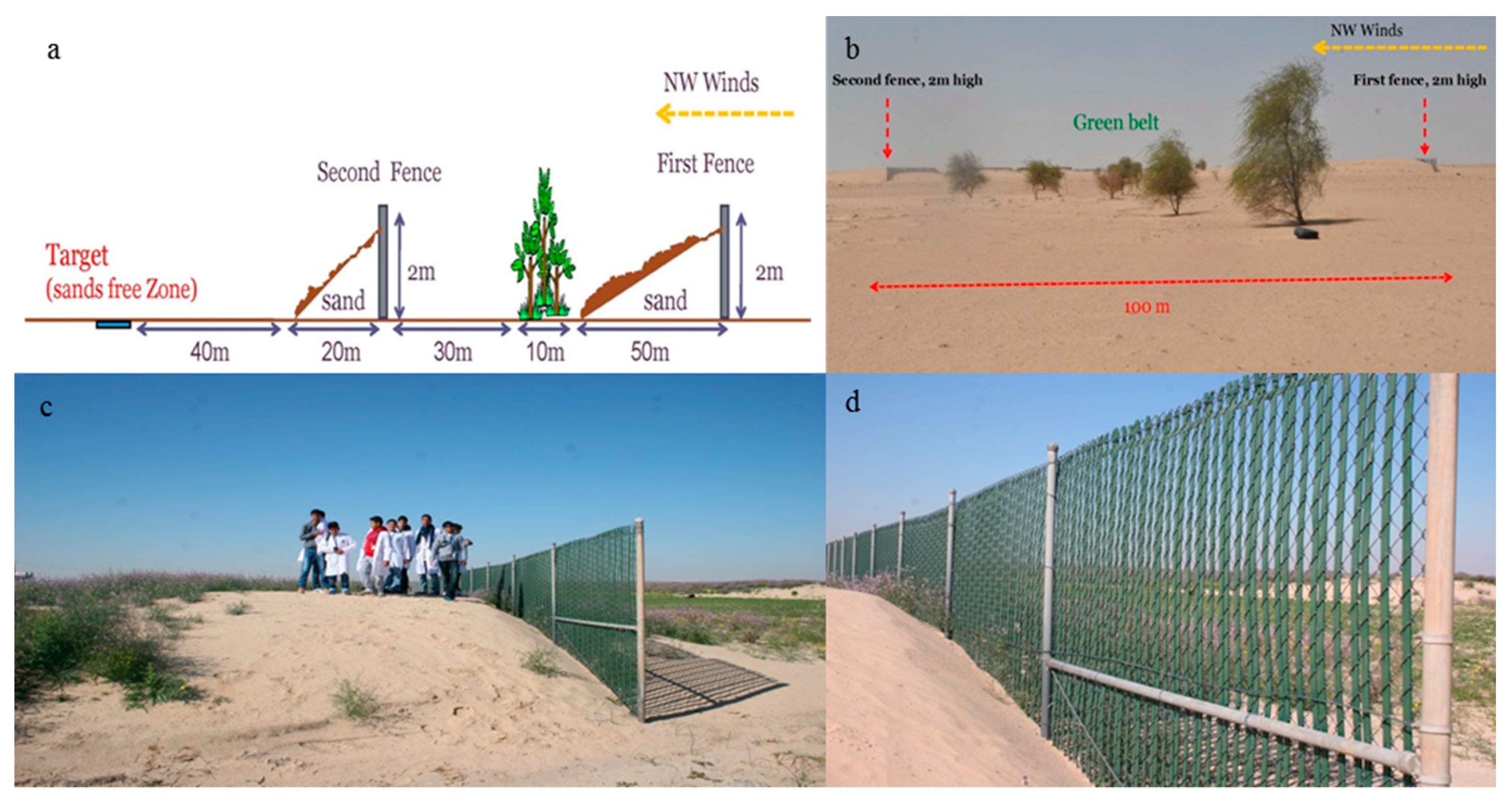
| Year of SDS | SDS Event | Impact | Country | SDS Event Cost | Reference * | |
|---|---|---|---|---|---|---|
| 1 | 2001–2014 | A total of 115 SDSs | Oil export, airline delay | Kuwait City | 1. $824,311 per oil tanker 2. $28,180 daily tactical airline | Al-Hemoud et al. [19] |
| 2 | 2013 | Unidentified SDS | Health, transportation (road and air), agriculture (cultivation and gardening) | Iran, Iraq | 1. $1.0435 B: Iran 2. $1.404 B: Iraq | Meibodi et al. [20] |
| 3 | 23/9/2009 | A single SDS ‘Red Dawn’ | Cleaning, air transport, construction, commercial, absenteeism, emergency services, farming, CO2-e | New South Wales, Australia | A$S299 M | Tozer and Leys [3] |
| 4 | 2000–2005 | A total of 335 SDSs | Cleaning, Car accidents, road damage, health, schools closed, house equipment | Sistan, Iran | $124.85 M | Miri et al. [21] |
| 5 | Annual | Unidentified SDS | Cleaning, health, electronics, car accidents, airline delay, signs, posts, irrigation | Yazd, Iran | $6.82 M | Ekhtesasi and Sepehr [22] |
| 6 | 2000 | A yellow dust storm | Manufacturing, agriculture, construction, trade, household | Beijing, China | $485.8 M | Ai and Polenske [23] |
| 7 | 2002 | A yellow dust storm | Health, cleaning, aviation, decrease in amenity | South Korea | $5600 M | Jeong [24] |
| 8 | Annual | Unidentified SDS | Health, households, power supply, car accidents, road maintenance, air transport | South Australia | A$23 M | Williams and Young [25] |
| 9 | Annual | Unidentified SDS | Households interior and exterior cleaning, road maintenance, landscaping | New Mexico, USA | $466 M | Huzsar and Piper [26] |
| (1) Negligible | (2) Slight | (3) Moderate | (4) High | (5) Very High | ||
|---|---|---|---|---|---|---|
| Impact | Human Injury/Fatality | None | Minor cuts or bruises: first aid | Serious injury: time off for recovery | Serious injury: long-term disability | One or more fatalities |
| Asset Damage | KD <1000 | KD 1000–10,000 | KD 10,000–100,000 | KD 100,000–1 M | KD >1 M | |
| Non-Productive Time | <8 h | 8–48 h | 49–168 h | 169–336 h | ≥337 h |
| Likelihood of Occurrence | Recurrence Frequency |
|---|---|
| (1) Very Unlikely | ≤1/year |
| (2) Unlikely | 2–3/year |
| (3) Possible | 4–5/year |
| (4) Likely | 6–7/year |
| (5) Very Likely | ≥8/year |
| Oil Sector | Date | Impact | Cost | Cost—2018 Prices (KD) |
|---|---|---|---|---|
| 1. Drilling Operations: KOC | 1/4/15–11/1/17 | 32.5 h | 18,525 | 19,081 |
| : KGOC | 17/4/10–10/7/15 | 479.5 h | 176,706 | 182,007 |
| 2. Production Operations | 1/1/16–31/12/16 | 280 h | 141,096 * | 145,329 |
| 3. Gas Operations | 1/1/16–31/12/16 | 280 h | 141,096 * | 145,329 |
| 4. Exploration | 1/1/16–31/12/16 | 280 h | 141,096 * | 145,329 |
| 5. Port and Marine Operations | 1/1/16–31/12/16 | 830 h | 418,250 * | 430,798 |
| 6. Soil Remediation | 22/2/16–15/12/16 | 52.5 h | 50,925 * | 52,453 |
| 7. Project Management | 8/4/10–28/12/16 | 2165 h | 1,090,978 * | 1,123,708 |
| 8. Water Handling | 1/1/16–31/12/16 | 280 h | 141,096 * | 145,329 |
| 9. Maintenance, Supp., and Reliab. | 17/8/14–16/8/16 | 199 h | 100,279 * | 103,288 |
| 10. Research and Development | 1/1/10–31/12/10 | 280 h * | 30,000 | 30,900 |
| 11. Sand Encroachment ** | 1/1/12–31/12/12 | 347,310 m3 | 277,848 | 286,183 |
| Total | 5158.5 h ~645 days | 2,727,898 KD ~US$9.09 M | 2,809,735 KD ~US$9.36 M |
| Consequence (Severity) | ||||||
|---|---|---|---|---|---|---|
| (1) Negligible | (2) Slight | (3) Moderate | (4) High | (5) Very High | ||
| Probability (Likelihood) | (1) Very Unlikely | Low | Low | Low | Low | Medium |
| (2) Unlikely | Low | Low | Low RD | Medium | Medium PMO | |
| (3) Possible | Low | Low | Medium SR | Medium | High | |
| (4) Likely | Low | Medium PO, GO, E, W | Medium | High MS | High PM | |
| (5) Very Likely | Low | Medium | High | High | High DO, SE | |
| Priority | Established | Components | Sustainability | Durability | Cost of 1 km Length |
|---|---|---|---|---|---|
| 1 | 2004 | Integrated mechanical–biological: Double impounding fences (about 100 m apart and 2 m high) and three rows of drought-resistant trees in the middle | High (Integrated mechanical and biological measures) | High 25–30 years (currently in use) | Total $198,000: $132,000 cost of 2000 m of chain-link fences + $66,000 (cost of 600 trees and irrigation for one year) |
| 2 | 1988 | Mechanical: Double impounding fences (2 m high, about 50 m apart) | Medium (mechanical double fences) | Medium 15–20 years (field result) | Total $132,000: Cost of 2000 m length of chain-link fences (cost of 1-meter length is $65) |
| 3 | 2008 | Mechanical: Single porous fence, 30–40 m upwind side of the road | Low (mechanical single fence) | Less than 10 years (field result) | Total $26,500 (cost of 1-meter length is $25) |
© 2019 by the authors. Licensee MDPI, Basel, Switzerland. This article is an open access article distributed under the terms and conditions of the Creative Commons Attribution (CC BY) license (http://creativecommons.org/licenses/by/4.0/).
Share and Cite
Al-Hemoud, A.; Al-Dousari, A.; Misak, R.; Al-Sudairawi, M.; Naseeb, A.; Al-Dashti, H.; Al-Dousari, N. Economic Impact and Risk Assessment of Sand and Dust Storms (SDS) on the Oil and Gas Industry in Kuwait. Sustainability 2019, 11, 200. https://doi.org/10.3390/su11010200
Al-Hemoud A, Al-Dousari A, Misak R, Al-Sudairawi M, Naseeb A, Al-Dashti H, Al-Dousari N. Economic Impact and Risk Assessment of Sand and Dust Storms (SDS) on the Oil and Gas Industry in Kuwait. Sustainability. 2019; 11(1):200. https://doi.org/10.3390/su11010200
Chicago/Turabian StyleAl-Hemoud, Ali, Ali Al-Dousari, Raafat Misak, Mane Al-Sudairawi, Adil Naseeb, Hassan Al-Dashti, and Noor Al-Dousari. 2019. "Economic Impact and Risk Assessment of Sand and Dust Storms (SDS) on the Oil and Gas Industry in Kuwait" Sustainability 11, no. 1: 200. https://doi.org/10.3390/su11010200
APA StyleAl-Hemoud, A., Al-Dousari, A., Misak, R., Al-Sudairawi, M., Naseeb, A., Al-Dashti, H., & Al-Dousari, N. (2019). Economic Impact and Risk Assessment of Sand and Dust Storms (SDS) on the Oil and Gas Industry in Kuwait. Sustainability, 11(1), 200. https://doi.org/10.3390/su11010200






